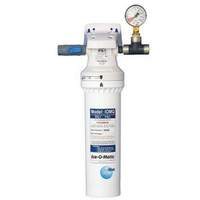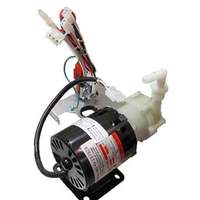Why restaurants need to clean and maintain ice machines

Ice is considered foodstuff by the FDA; therefore, it is one of the things that will be checked in any proper health inspection. Ice contaminated by mold and bacteria can spread illness just like any other food and is one of the most common health code violations. One of the major causes of contamination is improperly maintained ice machines.
Whether operating a cube, flaker or nugget machine, any environment where there is food being served, the food particles in the air increase the probability of slimy gunk developing in your machine as the particles interact with the water circulating through the machine.
It is important to develop an ice-machine maintenance schedule that includes regular cleaning and sanitizing, as well as servicing by a technician. If your machine is in a place where food is being served, the water supply may contain significant quantities of minerals that result in the water system being affected (think hard water) – requiring maintenance more frequently than twice a year.
Using water filters in your machine will help reduce scale buildup and help extend the life of your machine. Filters work to reduce the amount of sediment and minerals from the water.
Certain brand lines have upgraded their units to make cleaning even more efficient, such as the Scotsman Prodigy series, which has a one-touch cleaning feature and patented water purging system. Other manufacturers have added parts such as UV light bulbs that kill unwanted bacteria— a feature with most Manitowoc ice machines.
With most ice machines, you want to clean the entire interior, flush the water system, clean the condenser and filters and sanitize machine – basically perform full preventative maintenance a minimum of every six months, or as recommended by the manufacturer. Basic sanitizing of machine parts that get touched daily (scoop, handles, doors) should be done frequently.
Always call an experienced technician if experiencing recurring issues with heavy mineral deposits (scale), if ice is soft, not forming properly or if batches take too long to replenish.
Do not attempt to clean or disassemble your ice machine without first reading your specific model’s instruction manual.
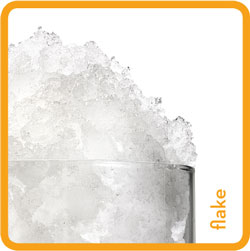
Flake ice
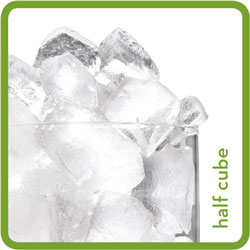
Half Cubed Ice
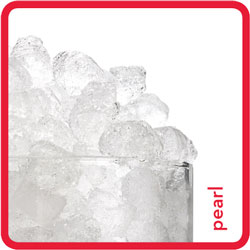
Pearl Ice
When approaching your preventative maintenance process, there are a few areas to take into consideration.
- The ice machine’s water system
- The ice bin or ice dispenser
- The ice machine’s air filter or condenser
The maintenance that should be performed on these items are
- Descaling
- Sanitation
- Filter cleaning or change
Remember, before starting the cleaning process for your ice machine, always use gloves when handling cleaning and sanitizing solutions. You may want to wear them from beginning to end of the entire process.
The Descaling Process
Most ice machines today will let you know when it's due for cleaning. These will have a “time to clean” light that goes off every six months. If it has been more than six months since the machine was cleaned, this is your indicator that the machine needs to be serviced by a technician.
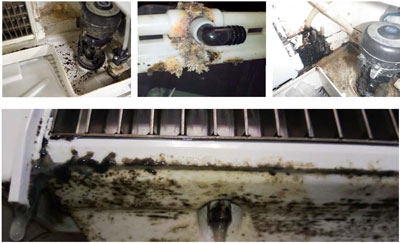
When using a cleaner to perform routine maintenance on your machine, the foodservice equipment pros advise using the manufacturer’s preferred ice cleaner brand and use the exact dilution ratio as specified in the instructions. Failure in taking either of these precautions could result in your machine being irreversibly damaged.
Before starting the descaling process, wait until the machine has finished its last harvest cycle and remove all ice from the storage bin. Place in bucket or bag for future use if you really want to hold onto it. Then remove the front panel of machine.
- To initiate the cleaning process, you must press the “clean” or “wash” button and wait until the water flows through the machine and indicates that it is OK to add chemicals (usually by a blinking light).
- Once that is complete, you can then add your manufacturer’s recommended food-grade acid cleaner for the cleaning process, which is most likely available from your local distributor.
Pro Tip: Run a cleaning cycle with the recommended solution once before removing any parts to make cleaning easier. - Most pros recommend that you simply take the bottle of cleaner and pour the recommended amount (usually 8 oz) behind the splash guard, or remove the guard completely and pour solution in the water trough.
The cleaner will dilute in the reservoir once you start the clean cycle and will run through the unit. You should always refer to your equipment manual to check the recommended dilution ratio for your cleaning solution. - It is perfectly normal to see foaming in the reservoir or other parts where you have cleaned with solution. That simply means the acid is working to dissolve mineral deposits.
- After 30 minutes of running the cleaning cycle, you may have to initiate rinse cycles to flush minerals and cleaner down the drain, if machine is not a newer, “one-touch” cleaning type.
- Depending on what brand and model you have, you may need to disconnect and/or remove components like the water curtain, trough, pumps, probes and water tubes for further cleaning in a sink, as these are parts that are most likely to have biofilm buildup.
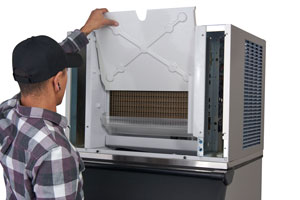
The water shield or "splash guard" is one of the first items removed for cleaning.
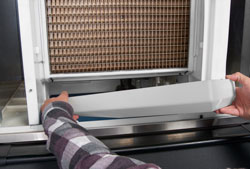
The water reservoir or "trough" should also be removed for cleaning.
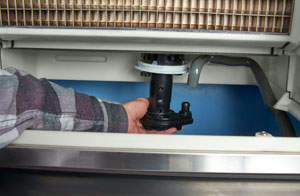
Water pump should also be removed if moldy/slimy. Be sure to keep any sensors dry when washing.
The sanitization process
- To sanitize the machine and parts, most manufacturers recommend using their preferred sanitizing solution (1 oz. of solution to 2 or 3 gallons of water) and sanitize the inside of the machine, including the ice bin, doors and seals.
Pro Tip: You can put some of the sanitizing solution in a spray bottle for easy use. - Reconnect and assemble machine parts in the reverse order from which they were removed.
- Press your machine’s “clean” or “wash” button to resume power. Then add proper amount of sanitizer solution to the water trough and let cycle through the machine.
- Set your machine to start making ice.
Machine parts that get touched daily such as the sanitizing scoop and the bin door, should be sanitized more often using basic soap and water. The ice scoop is the most important thing to sanitize on a regular basis, because of the number of people who touch it daily. More general sanitizing can be performed on a weekly or bi-weekly basis.
Cleaning the condenser and air filters
Keeping your condenser and air filters clean is necessary to keep your ice clear and your machine functioning properly.
Dirty filters and condensers can lead to restricted air flow and high operating temperatures, causing low ice production, streaking and white ice, as well as a shortened life span of your machine.
- Before cleaning your condenser, make sure to disconnect power to the machine or remote condensing unit by turning off their switches.
- You may want to shine a flashlight through the condenser and check for dirt between the fins.
If dirty, you can blow compressed air through the unit to clean, or use a soft bristle brush and a vacuum, and brush up and down the fins. Proceed with caution as condenser fence is sharp.
If you accidentally flatten the fins of the condenser fence make sure to straighten them out again. If the condenser is clogged with grease, you must contact a service technician to clean it. - After you have cleaned, recheck with flashlight for remaining dirt. If the condenser is still dusty or dirty, the pros at ACityDiscount recommend contacting a service technician.
Proper ice machine cleaning and maintenance is not only required by law, it is necessary for the safety of your patrons. Food safety experts are now saying that Department of Health inspectors are removing the front panel from ice machines to search for mildew as part of a standard inspection.
We know that a dirty machine can cost hundreds in fines, likely more than it would cost to hire a certified technician to service your machine. Performing preventative maintenance will ensure a higher health inspection grade, can save you unnecessary losses over the long term and help keep customers happy with your food quality.
Did you enjoy this article?
Subscribe to stay up to date on industry news and receive exclusive sales and promotions.



